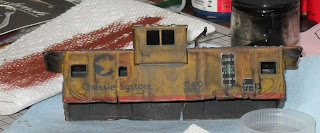Howdy again folks! Yeah I know it has been another 2 months again but not quite so there is improvement to the situation! So much has happened since our last time together so I should probably get started into it. To list it all out before the pictures interrupt there has been 1) module construction and completion, 2) my first train show to participate in (absolutely awesome!) 3) UP 1995 coming near when I actually had some time to chase for once and lastly 4) the open house up at the club. So you can see that a lot has been happening, and that is only train stuff, not the school grades being rather awesome currently, the B-24 and B-29 bombers visiting, traveling, and my bike being stolen! The last one not being good and all, but still a lot of fun stuff has been going on. Inorder to make this a smaller post, I will break up the 4 named things above into seperate posts. Now on to the meat of the update!
Module Construction and Completion:
This was one of those projects that kind of sneaks up on you. You start with a couple of months of time to finish, start taking your time, getting all of the details right and then, BAM!, only two weeks to the show and you haven't even painted the foam, or installed it, or even finished the frame...
However, I got the fire under my butt and got a move on. The scene I set out to create comes from an image on the Trinity Railway Express (TRE) line between Ft. Worth and Dallas that just called to me for some reason. That picture will be posted later in a comparison once this thing is finished to my full satisfaction.
And above is the (95%) finished product! The club standard is to ballast with WS medium gray ballast and my girlfriend painted the rails with a flat brown paint pen. Took me 30 minutes to test a 9 inch section, she did both mains in less than that... I love that woman. Anyways, I then laid the flex track down and soldered on the feeders to the bottom. More on that in a later post! I applied the ballast by first using a piantbrush to apply Elmers white glue around the bottom of the tracks and then sprinkle on some ballast with a plastic spoon. Once that was dry I sucked up the loose pieces with a vacuum and ballasted the rest. That was the typical pour it on, brush it gently into place, and then use a syringe to apply a 50/50 water glue mix. Once that dried I vacuumed up the loose stuff and fixed the empty spots. Then I turned my attention to the road. Since I did not want to mix more plaster (messy) or get sheetrock putty (it can flex better than the plaster during moving) I turned to other methods. What I came up with was manila folders! "Manilla folders? Surely you have lost your mind!" Truthfully I have not! (And don't call me Shirley -Thank you Leslie Nielsen) I was able to trim the manilla folders to fit onto the cork road guides and voila! Instant road that flexes and stretches! I attached the folder with track nails and Liquid Nail then painted over it with the black paint from the WS Paving Kit. Then I painted some quick stripes and markings, weathered it with powdered pastels, then walked away.
For now that is all I have to talk about regaring the module. The following posts will contain the updates on the other aforementioned events and cover why this module is only 95% done. At this point, it has taken me several days to write this, so, maybe I will get around to the others... Who knows eh?
As always, good luck and have fun!
For now that is all I have to talk about regaring the module. The following posts will contain the updates on the other aforementioned events and cover why this module is only 95% done. At this point, it has taken me several days to write this, so, maybe I will get around to the others... Who knows eh?
As always, good luck and have fun!



































